This Tiny Country Is a Less Crowded, Less Expensive Costa Rica
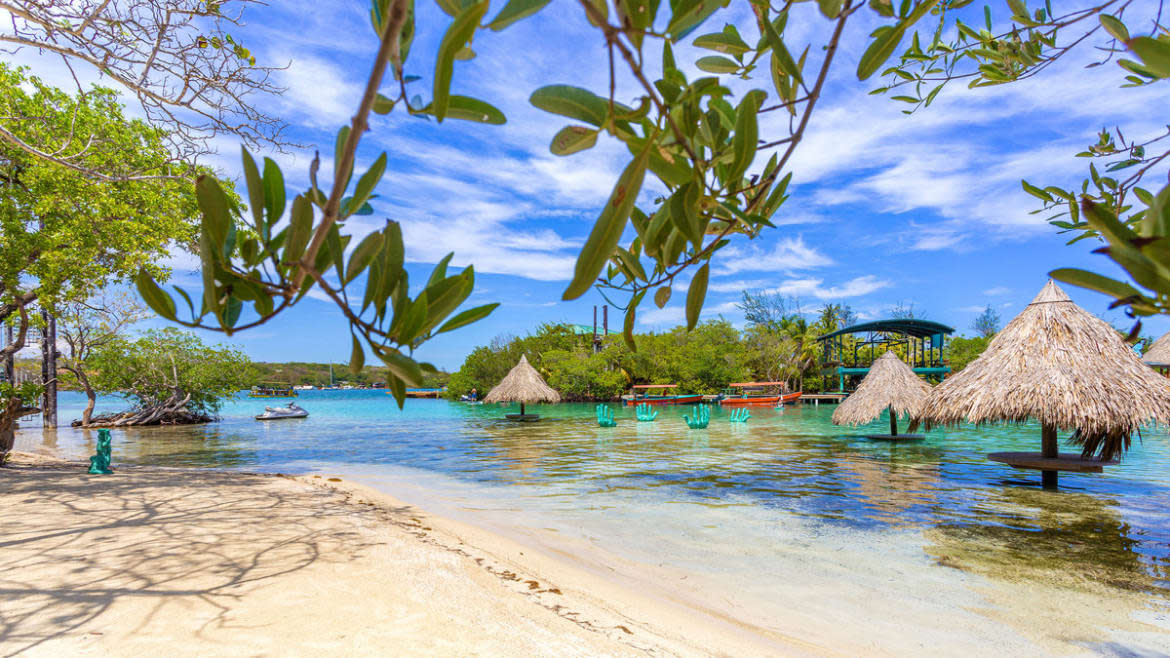
This is the latest in our series on underrated destinations, It's Still a Big World.
I went to Honduras for one reason: I love outdoor adventures but hate crowds.
For the past few decades, Costa Rica has worn the Central American crown in adventure travel, as it’s well-known for hiking, biking, surfing, zip-lining, and pretty much all things outdoors. Don’t get me wrong, I thoroughly enjoyed my action-packed trip to Costa Rica in 2020, but I know that’s partly because I visited right after the country reopened, so every single hotel and attraction I visited was empty.
Just think about it. How many people do you know have been to Costa Rica? I know five people who visited Costa Rica just last month alone, yet I only know two people who have ever visited Honduras. This surprised me because I’m a travel writer with many travel writer friends who are constantly jet-setting around the globe. As such, I placed Honduras at the top of my 2023 travel list.
Last month, I spent six days in Honduras, where I zip-lined, hiked down a cliff and behind a 143-foot waterfall, kayaked in a mangrove forest, rafted between two National Parks, and hiked in another National Park, where you can rent a six-person luxury cabin for an insanely low price of $300/night. I also cycled through rural, rarely explored areas and visited Central America’s largest and newest cypress tree labyrinth, which opened in January.
What I loved most about traveling in Honduras was that, unlike in Costa Rica or Mexico, where 90 percent of the travelers you meet are American, most of the travelers here are Honduran so you can enjoy the rare opportunity of traveling with locals. Most Americans I met were Honduran-American travelers returning to explore their birth country; the other chunk was a group of U.S. Army and Navy folks stationed at one of the bases. Apparently, the base organizes adventure trips for the troops every weekend.
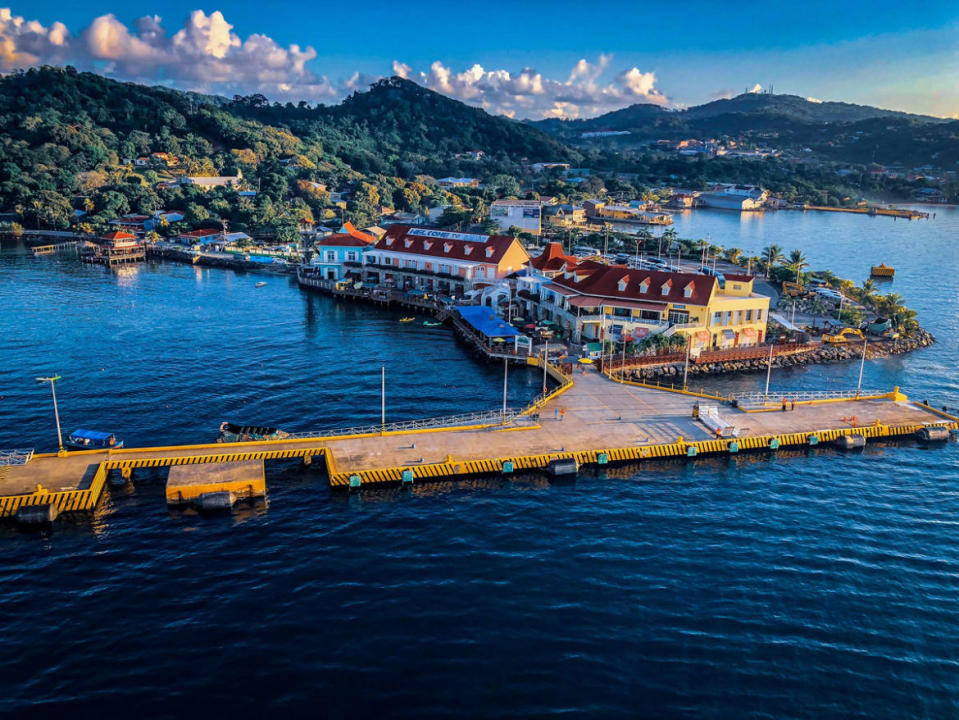
Coxen Hole Cruise Port in Roatan, Honduras.
Roatán
Of the very few Americans that do make it to Honduras, the vast majority go to two places: Roatán and Copán. Situated about 30 miles off the northern coast of Honduras, Roatán island is the perfect mix of beautiful beaches and superb snorkeling/diving, paired with plenty of bars and nightlife options. Think Tulúm but a bit less developed and without the endless drunken Spring Break vibe. To get to Roatán, you can catch a boat from nearby Cayos Cochinos, or hop on one of several daily flights from Houston, Miami, and Tegucigalpa. Since it’s easy to get here from the U.S., it usually makes the most sense to start here and then fly out of another airport (like Tegucigalpa) or to do the reverse.
To keep it even simpler, catch an hour-long ferry from La Ceiba (on the mainland) to the smaller, less-touristy Cayos Cochinos, which is within the Roatán municipality. Made up of two small islands and 13 smaller coral cays, Cayos Cochinos is about 20 miles northeast of La Ceiba. These “pig bays” are worth an overnight visit but are also easily visited as a day trip. Most visitors come here for two reasons: to visit beaches and to experience Garifuna culture. The Garifuna are the descendants of Carib Indigenous people and enslaved Africans who were exiled from British colonies in the eastern Caribbean in the 18th century.
Today, there are thriving Garifuna communities across Central America (and in the United States), but the largest population is found in Honduras, followed by Belize. In 2001, UNESCO declared the Garifuna culture a Masterpiece of Oral and Intangible Heritage of Humanity and you can book Garifuna Tours in Cayos Cochinos and elsewhere in Honduras.
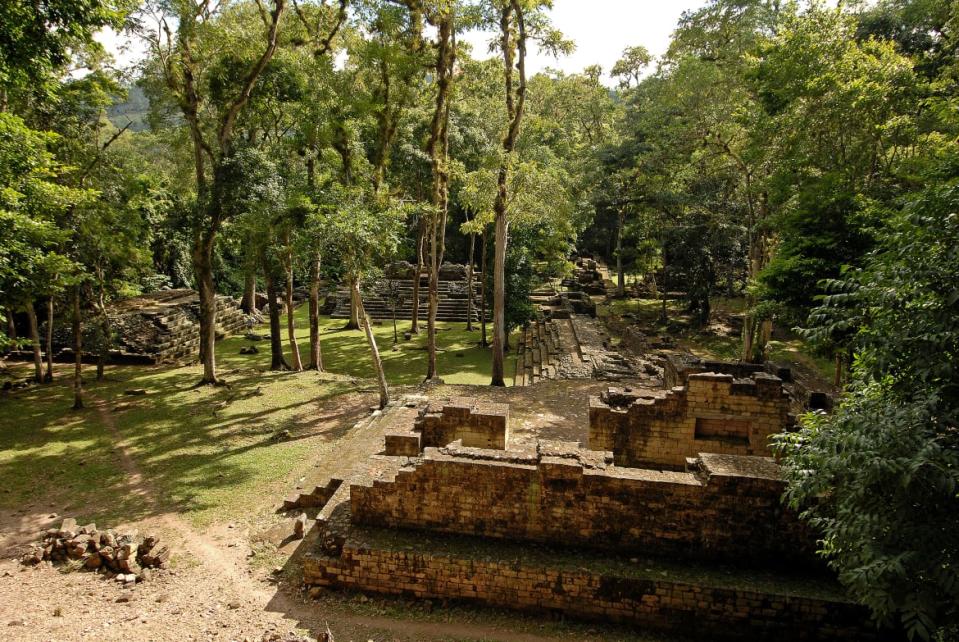
Copan temple in Honduras.
Copán
Honduras’ other claim to fame is Copán, one of the most important sites of the Mayan civilization, which was discovered in 1570 but not excavated until the 19th century. The entire city of Copán is a UNESCO World Heritage Site, where travelers can visit pyramids that the Mayans built to symbolize mountains, plazas to represent lakes, and doorways to suggest caves. The site was occupied for over 2,000 years and, today, Copán is famous for not only the number of its stone sculptures but also for the well-preserved quality of these stone columns, built to represent a “forest of kings.”
Because I didn’t want to spend seven hours (each way) in a car getting there and because I’ve visited so many other Mayan ruins (again, I’m a spoiled travel writer), I decided not to visit Copán. I only had six days in Honduras and I wanted to spend every waking moment doing something outdoorsy, so much to the surprise of every Honduran I met, I skipped the country’s national treasure. I’ll add, however, that every single traveler I met who had visited the site said it was spectacular. From what I heard, it’s well worth a day or two, as you can also zip-line, go horseback riding, visit a huge field of sunflowers, and tour coffee and tobacco farms.
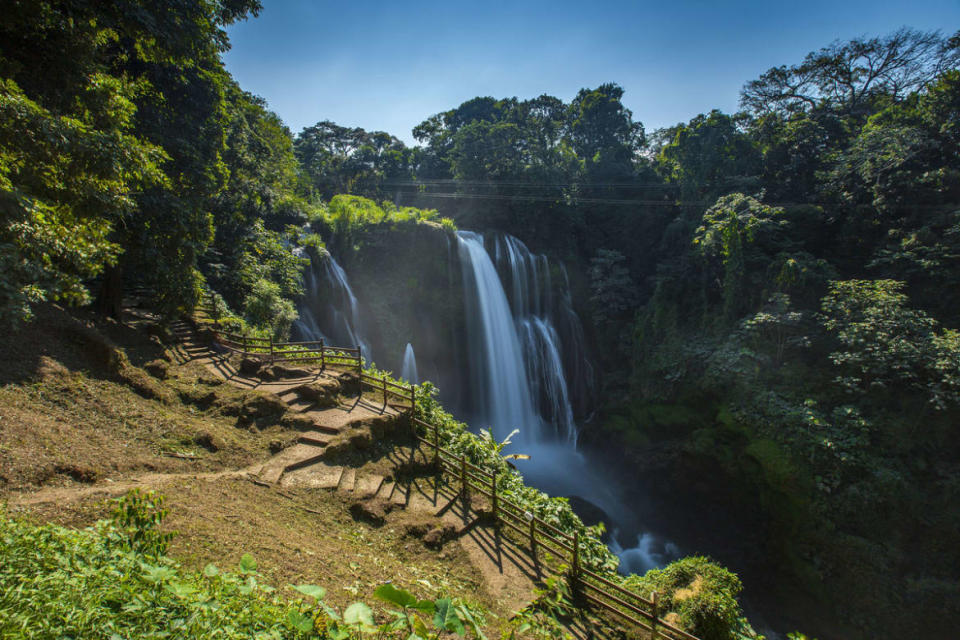
A picture of a mesmerizing Pulhapanzak waterfall on Lake Yojoa under the clear sky in Honduras
Pulhapanzak Waterfalls
My first stop in Honduras was Pulhapanzak, about a two-hour drive from the Comayagua Airport, where I flew in. Pulhapanzak is a 143-foot waterfall that can be engaged with in just about every way imaginable. Zip-line across the falls, climb down, behind, and under the falls, just take a selfie in front of them, or go kayaking in the quiet water behind it. It’s a popular day trip but you can also stay overnight at the onsite cabins, which is what I did. The cabins are modest but adequate and all the other guests were Hondurans and Honduran-born Americans who I stayed up with chatting around the campfire.
Come morning, a van pulled up full of Army and Navy folks stationed at a base two hours away. Since I was alone, I was partnered with their group for a zip-line tour. Shout out to the wild military man who shot and shared some epic videos of us gliding over the falls.
Zip-lining is not usually my favorite activity because, while it’s often included in the "adventure travel" category, I find it a bit too passive for my liking. Pulha, as the site is sometimes referred to, on the other hand, completely changed my mind. It’s not every day that you can crisscross above an enormous waterfall, surrounded by its massive spray while sopolotes (vultures) circle above. In a word, it was incredible.
Even more incredible was the climb down and behind the waterfall, which, in a word, was intense. Or, perhaps, insane, depending who you ask. The hike is broken into three increasingly harsh sections, where you have to swim across a narrow river, climb up and down stair-like rocks while water pounds down onto you, and hold a rope as you carefully shuffle your way along a rock shelf while the great Pulhapanzak releases its watery gates of hell from above. One of the women in my group stopped at the first section, which was probably smart, as my guide says that some people experience panic attacks when they get to sections with non-stop powerful bursts of water streaming down. I’ll admit to being a bit nervous at times, and I definitely tucked my glasses down into my bra, behind my life jacket, but, overall, I absolutely loved it.
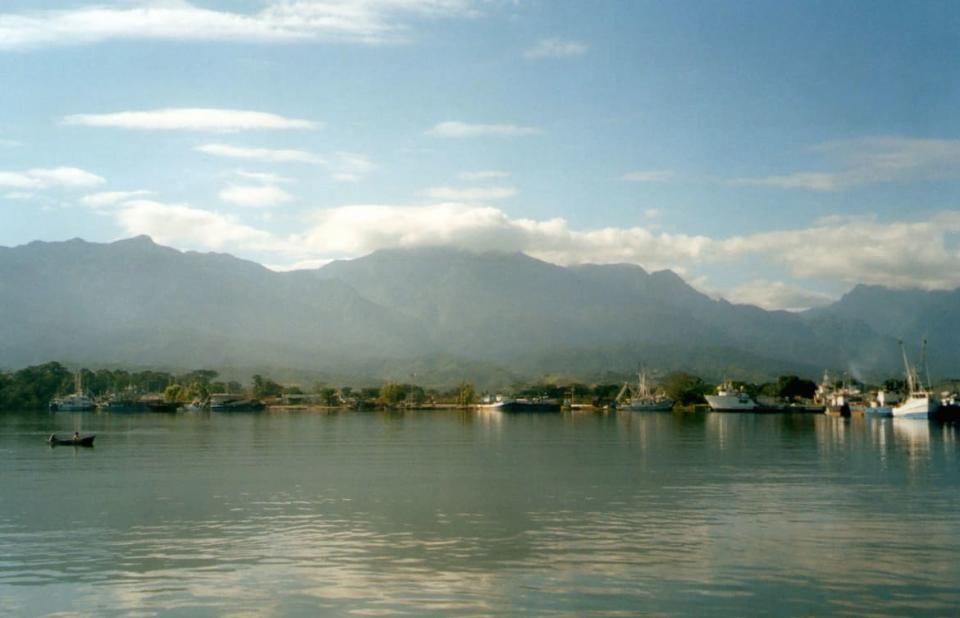
Pico Bonito mountain, a national park and one of Caribbean coast's tallest mountains, in the background of La Ceiba harbor, Honduras
La Ceiba, The Bride of Honduras
All around the northern port city of La Ceiba, considered by many to be the most beautiful city in Honduras, you’ll encounter colorful billboards referring to the area as “La novia de Honduras,”, or “The bride of Honduras.” The billboards showcase the area’s beaches, forests, and rivers this nature-rich region is known for and the photos are accurate. If I had to choose one favorite place in Honduras, it would definitely be La Ceiba. I started my visit at The Lodge & Spa of Pico Bonito, which is located within the Pico Bonito National Park.
Solo hiking within the park is possible but I’m glad to have gone with a local guide, who pointed out white crown parrots, black hawk eagles, toucans, tree frogs, monkeys, butterflies, and countless tropical plants and mushrooms. After the hike, I headed straight to the spa for a relaxing massage. Once at the spa, I learned that they also offer the traditional Mayan sweat lodge experience known as a temazcal. Having gotten hooked on the practice in Mexico about 10 years ago, I was disappointed not to be able to try it here, as you need to make a reservation the day before because the ceremonial stones take five hours to heat up. Word to the wise—make an advance reservation so you don't miss out.
The next day, I headed out on a kayaking tour of La Ceiba’s mangrove forests with La Moskitia Ecoaventuras. My guide, Emilio, is the son of the company’s founder and was a wealth of information. As we paddled through Lago de Cacao, he pointed out green herons, howler monkeys, and black hawks that have adapted to eating the local crabs. Tiny, rare pygmy kingfishers flew in front of us while some of the area’s 200 varieties of bats slept on the downed trees that we floated under. Emilio pointed out a nephila spider and explained that it spins a web so strong that scientists are trying to synthesize it as a substitute for iron. After a quick stop at the beach, we saw several crocodiles, which Emilio insisted never bother humans.
That afternoon, I headed out again with Moskitia Ecoaventuras to whitewater raft along the Rio Cangrejal, which flows between Pico Bonito National Park and the neighboring Nombre de Dios (Name of God) National Park. Though I didn’t have time to hike, guides told me that the 4-hour in-and-out hike to the 420-foot high El Bejuco waterfall is pretty incredible.
While in the area, I stayed several nights at the La Villa de Soledad, which is within walking distance to rafting and hiking opportunities. La Villa is a family-run colonial villa with enormous rooms, sky-high ceilings, hammocks on the patio, and a charm you won't find in any corporate hotel. The B&B, like many Honduran hotels and inns, can help arrange your taxis and excursions, so should you not book a driver or guide, reach out to them in advance to plan your trip. You can also work with trusted tour operators to book accommodations and drivers. I was extremely impressed with Moskitia Ecoaventuras, who assured me they can help travelers plan a multi-day adventure itinerary, including activities, accommodations, and drivers. Next time I visit Honduras, that’s exactly what I will do.
Comayagua
As the runways in the capital city, Tegucigalpa, are very short, Honduras recently unveiled a new international airport near Comayagua, about 80 minutes away. The majority of attractions are in the northern and western parts of Honduras, but it’s worth spending a day in/around Comayagua regardless of your plans. If you do only one thing here, make it a visit to Rancho Sofia. Don’t be fooled by the inordinate amount of cow photos on their social media page, as this is far more than a farm. This farm-turned-tourist attraction opened a small but stunning hotel two years ago with six rooms, multiple pools, plus camping options and a laundry facility. If it’s available, opt for the room with two floor-to-ceiling window walls overlooking the property.
Rancho Sofia also operates a small restaurant and “Cow Bar” that can only be described as John Deere meets Honduran bohemian chic. Yeah, I know. Think vodka cocktails and fresh dragon fruit juice on the patio, in a hammock, or in the elevated treehouse lounge area while the sounds of Madonna and The Weeknd drift through the air. You could easily drive here on your own but I arrived by bicycle with Julie Tours Travel, which took me on a 10-mile tour of small towns and farmland before stopping at the Jardín de Edén, which is just down the road.
Jardín de Edén, better known as the Cypress Labyrinth, began planting its 2,886 cypress trees (brought in from all over the country and neighboring El Salvador) in 2018. The trees were finally tall enough for the attraction to open its doors in December 2022, and visitors now spend anywhere from 30 minutes to 3 hours trying to find their way out of the maze. The site also has a large flower tunnel leading to a park studded with plants trimmed into the shapes of dogs, hearts, and everyday objects like cups. There’s also a large clock made of plants and bushes that’s been set to 9 o’clock because that's when Jesus died (Honduras is a very religious country). A handful of cabins have been built on site, completely surrounded by fuchsia-colored bougainvillea flowers, that should open next month, adding to the country's already impressive selection of unique accommodations.
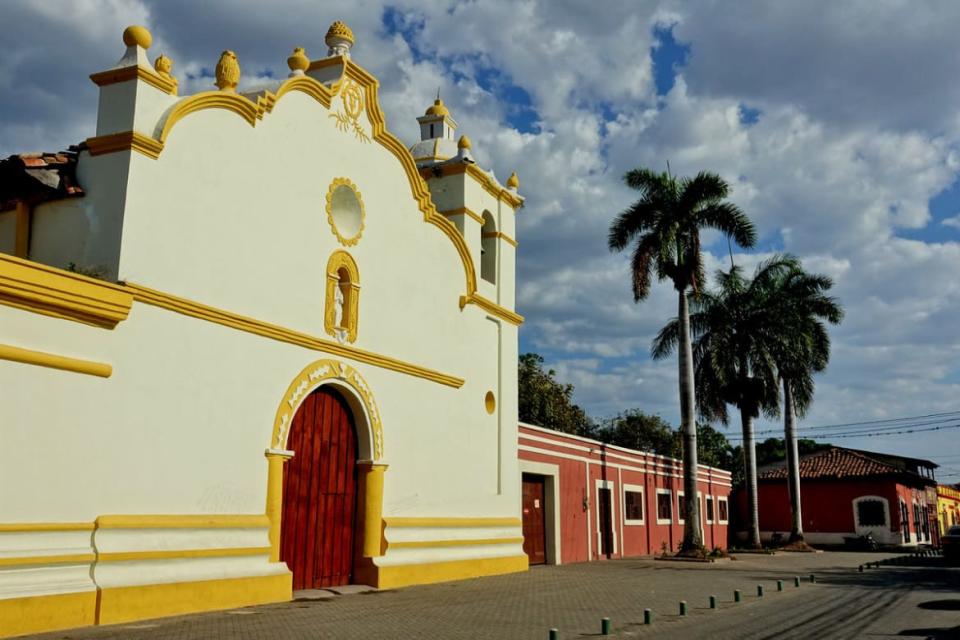
Comayagua Honduras.
Getting Around and Planning Your Trip
Like most Central American countries, you can rent your own car, hire a driver (with or without a guide), or get around by public transportation. You can pick up your car right from the airport and it’s best to reserve one in advance. If you book a driver, understand that they are just that—drivers—they are not tour guides and they may or may not speak English. Uber is also a good option for getting around larger cities (its unavailable in small cities and rural areas). However, for safety reasons, only accept drivers with a photo with profile information.
While it’s recommended to avoid public buses within Tegucigalpa for safety reasons, it is safe to take buses between cities (between Tegucigalpa and San Pedro Sula, for instance). If you rent your own car, know that the roads are in decent (but not great) condition and you can usually get by with a sedan. If you plan to drive yourself to off-beat nature hikes, kayaking trips, or to that gorgeous colonial villa I stayed in, definitely consider getting a mini-SUV, which is what I rode in.
Google Maps works fairly well (though several times it tried sending us the wrong way down a one-way street), but know that it may suggest a shortcut through an area that isnt the safest. This is only a real concern if you’re driving in Tegucigalpa, which, as you’ll learn later, can (and should) be skipped if you have limited time in the country.
Even if you want to do your own thing and drive alone, it still may be worth hiring an agency to help plan your itinerary, book hotels, and even map your driving route so you stay on the right track. If you do drive alone, avoid driving at night for security purposes and because some highways aren’t well marked so it’s easier to get lost at night. Also, make sure to reserve an automatic car as stick shifts are often the default in much of Latin America.
Having local currency (lempiras) is best but, if you’re in a pinch, many places catering to tourists (accommodations, restaurants, excursion companies) accept USD. I also found that several hotels and tour companies exchange money, which is easiest to do during the week since they don’t do bank runs on the weekend.
Though pre-planning is a good idea in any country, figuring things out is fairly easy once you get to Honduras. Everywhere I went, I met travelers who shared tips for where to go and highly knowledgeable guides gave me advice for what I’ll do next time I return.
Speaking of guides, I got my car and guide through Andy Paraiso Tours. Actually, I was assigned a travel agent, not a guide, which seems common here, and it worked well since I had local experts for all my adventures. Unfortunately, the Travel Honduras website has a lot of broken links, but it does have good information worth reviewing. If you like the idea of visiting multiple destinations in Central America, Visit Centro America is a great website that allows you to search for tours by country, activity, and length of stay.
In general, guides speak English, prices are extremely affordable, and Honduras uses the same electrical outlets as the U.S. so you don’t need to bring a converter. All the places I stayed had Wi-Fi (though signal strength varied), and my international data plan usually allowed me to browse and text freely, and I was even able FaceTime a few times.
Safety
Honduras has historically received fewer visitors than Costa Rica because it has experienced far more crime and violence than its Central American neighbor, famously known for not having a military. While there were many more problems and safety concerns in the past, the situation has improved substantially. The country experienced a coup in 2009, and a later president was arrested and extradited to the United States on drug trafficking charges. Still, the government has since declared war on gangs, and Honduras has experienced a steady and significant drop in homicides over the past decade.
Does Honduras still have issues with drugs and violence? Yes, but it’s mostly limited to the northeasternmost province, Gracias a Dios, and certain neighborhoods in Tegucigalpa. Because the rest of the country is way more interesting and beautiful, most travelers will want to skip Tegucigalpa anyway.
While I did visit Tegucigalpa (with a local guide who knew what neighborhoods were safe), I couldn’t make it to the colonial city center because there was a large political protest that day. These protests are somewhat common and may be accompanied by violence, so instead of touring the downtown area, we spent our time stuffing our faces with the popular street snack, baleadas. The astoundingly addictive snacks (usually eaten for breakfast or as an evening snack) are thick corn tortillas stuffed with beans, eggs, and mantequilla, a creamy liquid butter. These egg, bean, and buttery treats are basically a takeaway version of the traditional Honduran plate, minus the plantains, plus a helping of cabbage curtido slaw. Do not leave the country without trying them.
COVID Concerns
While much of the world has completely eliminated COVID restrictions and one could easily forget that the pandemic hasn’t ended, Honduras is still taking COVID fairly seriously. Masks are required on domestic flights, in airports, and in public places. Even when masks aren’t required, they are the norm in many indoor settings, from supermarkets and pharmacies to cafes and hotels. As such, even if you usually go without a mask, it would be polite to carry one with you to use indoors if that’s what you see most people are doing.
To visit Honduras, you’ll also need to show proof of vaccination or a recent negative PCR test before boarding your flight and again when you land in Honduras. Travel insurance isn’t required (though I bought a World Nomads plan because I’m a huge believer in comprehensive travel insurance), but you do have to fill out a health form 72 hours before your departure.
Getting to and from Honduras is fairly easy, as is getting around the country, communicating, exchanging money, and finding safe and wonderful adventures. While I selfishly hope the country doesn’t become completely overrun with tourists in the near future, it absolutely is a possibility. Until then, now is the time to enjoy an underrated, under-visited small Central American paradise that’s happy to have you and just about guarantees you a great time.
Cassandra Brooklyn is a writer, travel expert, and group tour leader. She runs EscapingNY, an off-the-beaten-path travel company, and is the author of the guidebook Cuba by Bike.
Get the Daily Beast's biggest scoops and scandals delivered right to your inbox. Sign up now.
Stay informed and gain unlimited access to the Daily Beast's unmatched reporting. Subscribe now.

